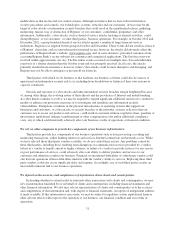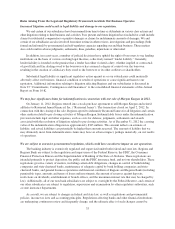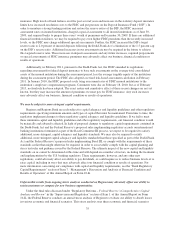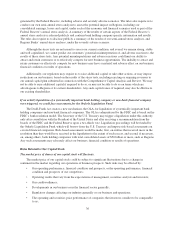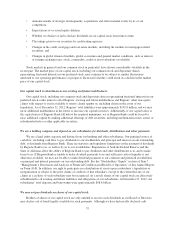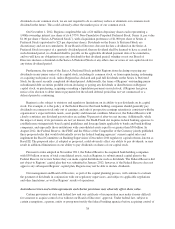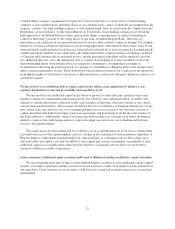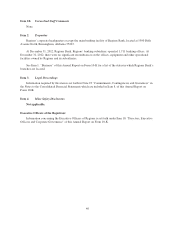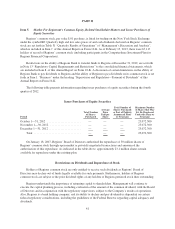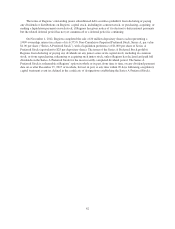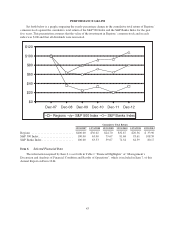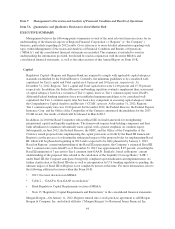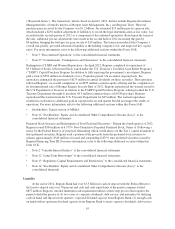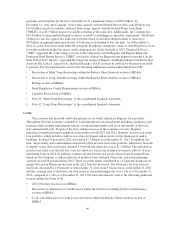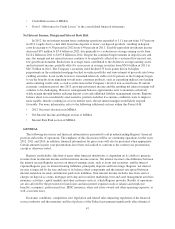Regions Bank 2012 Annual Report Download - page 55
Download and view the complete annual report
Please find page 55 of the 2012 Regions Bank annual report below. You can navigate through the pages in the report by either clicking on the pages listed below, or by using the keyword search tool below to find specific information within the annual report.a bank holding company. Acquisition of 10 percent or more of any class of voting stock of a bank holding
company or state member bank, including shares of our common stock, creates a rebuttable presumption that the
acquirer “controls” the bank holding company or state member bank. Also, as noted under the “Supervision and
Regulation” section of Item 1. of this Annual Report on Form 10-K, a bank holding company must obtain the
prior approval of the Federal Reserve before, among other things, acquiring direct or indirect ownership or
control of more than 5 percent of the voting shares of any bank, including Regions Bank. There also are
provisions in our certificate of incorporation that may be used to delay or block a takeover attempt. For example,
holders of our Series A Preferred Stock have certain voting rights that could adversely affect share value. If and
when dividends on the preferred stock have not been declared and paid for at least six quarterly dividend periods
or their equivalent (whether or not consecutive), the authorized number of directors then constituting our Board
of Directors will automatically be increased by two, and the preferred stockholders will be entitled to elect the
two additional directors. Also, the affirmative vote or consent of the holders of at least two-thirds of all of the
then-outstanding shares of the preferred stock is required to consummate a binding share-exchange or
reclassification involving the preferred stock, or a merger or consolidation of Regions with or into another entity,
unless certain requirements are met. These statutory provisions and provisions in our certificate of incorporation,
including the rights of the holders of our Series A Preferred Stock, could result in Regions being less attractive to
a potential acquirer.
We may need to raise additional debt or equity capital in the future; such capital may be dilutive to our
existing shareholders or may not be available when needed or at all.
We may need to raise additional capital in the future to provide us with sufficient capital resources and
liquidity to meet our commitments and business needs. Our ability to raise additional capital, if needed, will
depend on, among other things, conditions in the capital markets at that time, which are outside of our control,
and our financial performance. The economic slowdown and loss of confidence in financial institutions over the
past several years may increase our cost of funding and limit our access to some of our customary sources of
capital, including inter-bank borrowings, repurchase agreements and borrowings from the discount window of
the Federal Reserve. Additionally, some of our long-term debt securities are currently rated below investment
grade by certain of the credit ratings agencies. Any such ratings may affect our cost of funding and limit our
access to the capital markets.
We cannot assure you that capital will be available to us on acceptable terms or at all. Any occurrence that
may limit our access to the capital markets, such as a decline in the confidence of debt purchasers, depositors of
Regions Bank or counterparties participating in the capital markets, or a downgrade of our debt ratings, may
adversely affect our capital costs and our ability to raise capital and, in turn, our liquidity. An inability to raise
additional capital on acceptable terms when needed could have a materially adverse effect on our business,
financial condition or results of operations.
Future issuances of additional equity securities could result in dilution of existing stockholders’ equity ownership.
We may determine from time to time to issue additional equity securities to raise additional capital, support
growth, or to make acquisitions. Further, we may issue stock options or other stock grants to retain and motivate
our employees. These issuances of our securities could dilute the voting and economic interests of our existing
shareholders.
39




